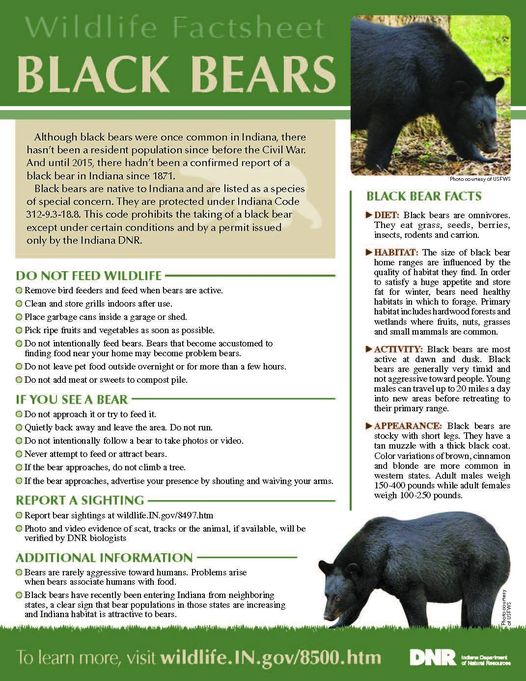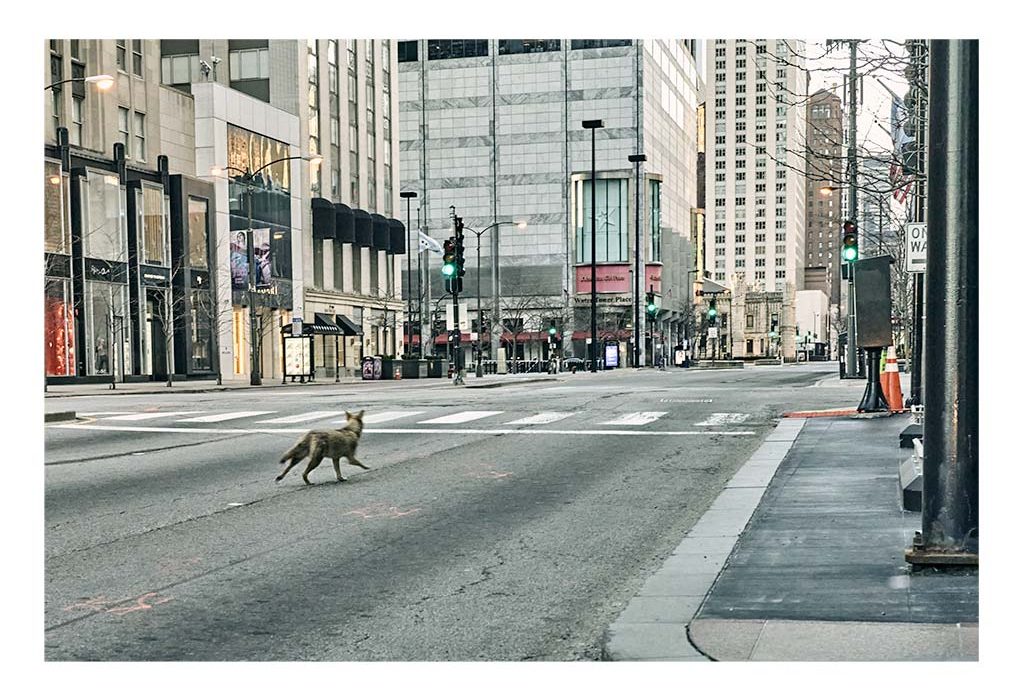Thursday, May 23, 2024 post by Fort Wayne Animal Care & Control on Facebook:
It is baby season and we are feeling it with the high amount of wildlife calls we are receiving. We are appreciative of people with good intentions who try to help wildlife when they think they need assistance, but sometimes those baby animals don't need help and you could be baby wildlife-napping.
We encourage you to read through the slides we have created with information from The Humane Society of the United States. You can read the full article here: Found an orphaned or injured baby wild animal? How to tell if baby animals are orphaned, injured or perfectly fine—and what to do if they need your help
The most important thing to remember is baby wildlife has the best chance at survival with their mom (the same goes for kittens!) If they are in immediate danger or are injured, please call us at (260) 427-1244 option 1 or your local wildlife rehabber. You can visit Indiana DNR to search for licensed rehabbers in your area: Indiana DNR Permitted Wildlife Rehabilitators
***FWACC can only assist with injured or sick wildlife calls. Unless the wildlife is stuck inside your home, we legally cannot relocate wild animals off your property; remember this is their home! Please do not touch wildlife with your bare hands. Learn more on our website: Wildlife
Beavers - Castor canadensis
Beavers (Castor canadensis) were once rare in Indiana due to overharvesting but are now abundant. In 1935, the Indiana Department of Conservation obtained a few breeding pairs from Wisconsin and released them on Jasper-Pulaski Fish & Wildlife Area. Beaver populations expanded, aided by strategic relocations to certain parts of the state to help with expansion. Presently, beavers are found in almost every county. Copied from Beaver at Indiana Department of Natural Resources. "Although the species currently is considered secure across its range, unregulated fur harvest and habitat destruction caused severe declines or extirpation of beavers by 1900 in many parts of the United States." From North American eaver (Castor canadensis): A Technical Conservation Assessment Prepared for the USDA Forest Service, Rocky Mountain Region, Species Conservation Project February 6, 2007 at fs.usda.gov.
Sunday, December 4, 2016 post by Riverfront Fort Wayne on Facebook:
Several beavers living in the rivers in Downtown Fort Wayne have been gnawing the bark off the base of large trees along the riverbanks, which eventually kills the trees and can lead to the tree falling into the river, said Dan Wire.
Sunday, April 7, 2024 post by the U.S. Forest Service - Hoosier National Forest on Facebook:
Happy International Beaver Day!
Beavers were once rare in Indiana due to overharvesting for their fur but are now abundant.
In 1935, the Indiana Department of Conservation obtained a few breeding pairs from Wisconsin and released them in strategic relocations to certain parts of the state to help with expansion.
The population expanded and now beavers are found in almost every county.
- Beavers: Our Ecosystem Engineers 06/13/2019 Riverfront Fort Wayne.
- Beavers have killed around 150 city trees along the rivers, so city is wrapping them with wire to prevent more losses. Beavers make their way to downtown Fort Wayne, destroy trees
Black bear - Ursus americanus
- Bear cub mentioned in 1859 newspaper clipping 1859 - Fort Wayne in Old Times - General Harmar's Campaign in 1790 - Miami Village - bear cub Dawson's Fort Wayne Weekly Times, Fort Wayne, Indiana, Saturday, September 10, 1859, Page 1.
Black bears (Ursus americanus) were historically abundant across Indiana, excluding the northwest portions of the state dominated by prairie. Unregulated hunting and habitat loss caused black bears to be extirpated from Indiana and much of the Midwest by 1850. Today, black bear populations are expanding and they may pass through Indiana from established populations in adjacent states. In recent years, four black bears have been confirmed (2015, 2016, 2018, 2021) in Indiana. Copied from Black Bear at the Indiana Department of Natural Resources.
June 12, 2015 post by the Indiana DNR Division of Fish and Wildlife on Facebook:
Here's some exciting news! The first wild black bear to wander into Indiana since 1871 was confirmed in St. Joseph County.
Black bears eat mostly plants and berries this time of year, and especially love bird seed due to the high fat content. They are still a wild animal, so keep your distance, but feel free to observe from afar and send any photos or sightings to dfwinput@dnr.in.gov.
Entire story: Wandering black bear confirmed in St. Joseph County [ Archived on the Internet Archive Wayback Machine ]
Photo Courtesy of: USFWS (not of the bear currently in Indiana)
December 3, 2018 post by the Indiana DNR Division of Fish and Wildlife on Facebook:
A trail camera photo of a black bear from November 23 in Clark County, Indiana was recently confirmed by DNR staff. The bear can be seen walking along the edge of a standing soybean field. This is likely the same bear that was reported in the New Albany area on Nov 18 after being struck by a vehicle. These reports are 10 miles apart indicating that the bear was still active and moving after the accident. A black bear is not cause for concern, but citizens are encouraged to be BearWise to minimize potential conflicts and not leave out food for the bear or attempt to approach it. Visit bearwise.org for tips on living with black bears and read our factsheet below for bear information. Learn more about black bears, report sightings, and download the pdf of the factsheet at our black bear webpage: Black Bear
June 27, 2021 post by the Indiana Department of Natural Resources on Facebook:
CONFIRMED: Black bear in Vanderburgh County
DNR biologists have confirmed a black bear sighting that occurred in northeast Vanderburgh County before sunrise this morning. The closest town to the location is Elberfeld, in Warrick County.
Biologists confirmed the bear from photos taken by the landowner.
“This is Indiana’s fourth confirmed black bear,” said Brad Westrich, DNR mammalogist. “With expanding bear populations in neighboring states, this is expected.
“Human-bear conflicts can be avoided if you remove or secure potential food sources from your yard. Bears can smell food from more than a mile away.”
Black bears are rarely aggressive toward humans.
If you see a black bear:
— Do not feed it.
— Observe it from a distance.
— Do not climb a tree.
— Advertise your presence by shouting and waving your arms and backing slowly away.
— Report bear sightings to the Indiana Division of Fish & Wildlife at Report A Mammal
Most problems that occur with bears arise when bears associate food sources with humans and lose their fear of people.
More guidelines for reducing or eliminating the potential for bear-human conflicts:
— Remove bird feeders and bird food if a bear is reported in your area.
— Clean and store away grills after use.
— Eliminate food attractants by placing garbage cans inside a garage or shed.
— Pick ripe fruits and vegetable as soon as possible or place an electric fence around them to ensure bears cannot reach them.
— Consolidate beehives you may have and place an electric fence around them.
— Don't leave pet food outside overnight.
— Don't add meat or sweets to a compost pile.
— Don't climb a tree if you encounter a bear; wait in a vehicle or building for the bear to leave the area.
More information on black bears is at Black Bear
Saturday, March 16, 2024 post by the U.S. Department of the Interior on Facebook:
As winter fades and spring begins, black bears emerge from their dens and new cubs get their first glimpses of the outside world.
For the first several weeks, the bears wander lazily, snacking on fresh leaves and stealing nut caches from squirrels. Their appetites increase as berries and acorns become abundant and the cubs quickly learn survival skills like foraging and climbing. Not everyone can get by on their cute looks alone.
Photo at Shenandoah National Park by Joel Brown
Friday, June 7, 2024 post by the U.S. Department of the Interior on Facebook:
Family portrait! 
Seeing a bear in the wild is a special treat for visitors on public lands. While it is an exciting moment, it is important to remember that these bears are wild and can be dangerous.
If you see a bear, remember you are a visitor in its home. Keeping your distance and not surprising bears are some of the most important things you can do to avoid an encounter. Pay attention to your surroundings and make a special effort to be noticeable in bear country.
Learn more about staying safe in bear country: Staying Safe Around Bears
Photo by Taylor Albright
Our gift for you today: the chance to squee over these cute bear cubs. As the days reach their shortest, the black bears at Rio Mora National Wildlife Refuge in New Mexico work hard to finish building the fat stores they worked on all season. Once food becomes unavailable, they make their way to their dens for a good slumber. Momma bear will get her cubs through their first winter and send them on their way in spring. Video Description: A mother bear ambles along a refuge service road while her two cubs run ahead of her. USFWS
Posted by U.S. Fish and Wildlife Service on Thursday, December 19, 2024
Thursday, December 19, 2024 post by the U.S. Fish and Wildlife Service on Facebook:
Our gift for you today: the chance to squee over these cute bear cubs.
As the days reach their shortest, the black bears at Rio Mora National Wildlife Refuge in New Mexico work hard to finish building the fat stores they worked on all season. Once food becomes unavailable, they make their way to their dens for a good slumber. Momma bear will get her cubs through their first winter and send them on their way in spring.
Video Description: A mother bear ambles along a refuge service road while her two cubs run ahead of her. USFWS
Bobcat
Geriann Albers, a Furbearer Biologist for the Indiana Department of Natural Resources, told WANE 15 that bobcats started to move into southern Indiana in the late 1900s. Now, they’re migrating into northeast Indiana. “They’re doing this because they like to follow our river corridors,” Albers explained. “So, they moved to the southern part of the state and they’re following our rivers, basically, up into northern Indiana and over. Now they’re moving down into our northeastern and eastern part of our state.” While bobcats are more nocturnal, secretive animals, Albers said more and more sightings are happening thanks to trail and security cameras.
More bobcat sightings are occurring in northeast Indiana; why are they coming here? Rex Smith June 20, 2023 on CBS WANE-TV NewsChannel 15.
Thursday, January 16, 2025 post by U.S. Fish and Wildlife Service on Facebook:
Here kitty, kitty!
Want to see a bobcat? Don't forget to look up! Bobcats are great at climbing and will often use trees to wait for prey or even escape larger predators. While they typically hunt at dawn and dusk, they're more active during the day in the winter.
 courtesy of Nicholas Shaw
courtesy of Nicholas Shaw
Groundhog
February 2, 2024 post by Purdue Extension - Sullivan County on Facebook:
Punxsutawney Phil says spring is right around the corner!
Or is it?
Although Groundhog Day is a great tradition enjoyed by millions of Americans, groundhogs might not be the best weather forecasters…but they are still very impressive animals. Click the link to see what Purdue Extension Wildlife Specialists have to say on the subject: Groundhogs can’t predict the weather but they do poop underground
February 2, 2024 post by NOAA National Centers for Environmental Information on Facebook:
 Happy Groundhog Day! It’s that time of year again where we wonder: To winter or not to winter? Since we can’t control spring like Persephone, we’ll tune in to a furry little “forecaster” named Punxsutawney Phil. While his accuracy rate has fallen to 30% over the past decade, you can always count on him to look cute and grumpy at the same time.
Happy Groundhog Day! It’s that time of year again where we wonder: To winter or not to winter? Since we can’t control spring like Persephone, we’ll tune in to a furry little “forecaster” named Punxsutawney Phil. While his accuracy rate has fallen to 30% over the past decade, you can always count on him to look cute and grumpy at the same time.
This year, he didn’t see his shadow, which means an early spring! Whether you’re rejoicing that your cardigan can get more outings or celebrating that those pale noodles called your legs might finally see some sun—we’re just happy to hop back into bed. Learn more about Phil’s past predictions here: http://bit.ly/GroundhogsAndClimate #PunxsutawneyPhil
Friday, April 19, 2024 post by Fox Island County Park on Facebook:
*FUN FACT FRIDAY*
The answer to TALK TO ME TUESDAY's Who am I clues is...
the GROUNDHOG!
Here are some more fun facts:
Groundhogs are sometimes called whistlepigs. This funny name comes from their habit of whistling at potential mates.
Some people refer to groundhogs as woodchucks. The name comes from a Native American word, wuchak.
Groundhogs are known for digging huge burrows to live in, and they can move up to 700 pounds of soil to create their home.
When the groundhog builds its home, it actually builds a bathroom. It’s a designated place away from the space where the family sleeps or stores its food.
Groundhogs can eat more than a pound of food in one sitting!
Groundhogs can hold their breath for up to 5 minutes when diving into water to escape danger.
It’s found only in the United States and Canada.
They may not look like the squirrels you’re used to seeing, but groundhogs are the largest member of the squirrel family.
Two of the groundhog’s 22 teeth — the top incisors — continue to grow throughout the animal’s life at a rate of 1/16 of an inch every week.
Raccoon
December 6, 2022 post by Wild Birds Unlimited (Ft. Wayne, IN) on Facebook:
Are raccoons on your naughty or nice list??
Did you know that today, there are 20 times more raccoons in cities than 70 years ago? Have to hand it to them; they sure know how to adapt!
February 9, 2024 post by Fox Island County Park on Facebook:
*FUN FACT FRIDAY*
The answer to Talk to Me Tuesday is... the Raccoon!!
Here are some Fun Facts for you:
• The popular nickname for Raccoons is Trash Panda because they am intelligent and adaptable so have learned to source food around humans.
• Raccoons “see" with their hands
Raccoons are often seen “washing” their food in water before they eat it. This behavior is because raccoons have very dexterous front paws, which they use to feel around and explore their surroundings. Their paws are way more sensitive than human hands and can pick up on things that we would never notice.
• When raccoons do their “washing” routine, they actually feel the texture and temperature of objects and things in their environment and try to determine if those are safe to eat or not. Raccoons also have 5 fingers on each paw, which gives them a very human-like grip. This gives them the ability to open jars, doors, and even latches.
• Raccoons prefer to be out at night. (nocturnal)
• They do not truly hibernate but put on extra fat in the fall so when they need to sleep during an extra cold they will still be okay.
• They are great climbers with hind feet that rotate 180 degrees, allowing them to descend head first.
• Once people feed raccoons, they will become a nuisance because they will eat almost anything.
• In the wild, raccoons eat clams, crayfish, frogs, fish, snails, insects, dead animals, bird eggs, fruits, and vegetables.
• Raccoons live in abandoned burrows, under rock piles, hollow logs, and holes in trees. Or, you might find me in attics, crawl spaces, chimneys, and abandoned vehicles.
FOR MORE INFORMATION:
Meet your urban wildlife neighbours: 5 things to know about urban raccoons
13 Truly Interesting Facts About Raccoons`
Wolves
Wolves became such a menace because of the abundant game that bounties were offered, and farmers competed with one another in the number of wolf traps they could set.
From South Wayne area was once a city unto itselfby MICHAEL HAWFIELD from the archives of The News-Sentinel inCityscapes - People & Places series of articles from the archives of
The News-Sentinel newspaper on our South Wayne page.
Indiana also paid a bounty to kill wolves and other predators.
Monday, March 4, 2024 post by Greene County (Ohio) Archives on Facebook:
"Ordered that Christopher Hussey be allowed nine dollars for 6 wolf scalps over the age of six months also one dollar + a half for one wolf scalp."
Did you know that in Ohio in the early 1800s counties would pay individuals to kill wolves?
Apparently Christopher Hussey was quite the hunter, bringing in seven wolf scalps for a total of ten and a half dollars.
These records in Greene County can be found in the entries of the Commissioner's Journals back to 1803 when Greene County was founded!
Image: Greene County Commissioner's Journals.


